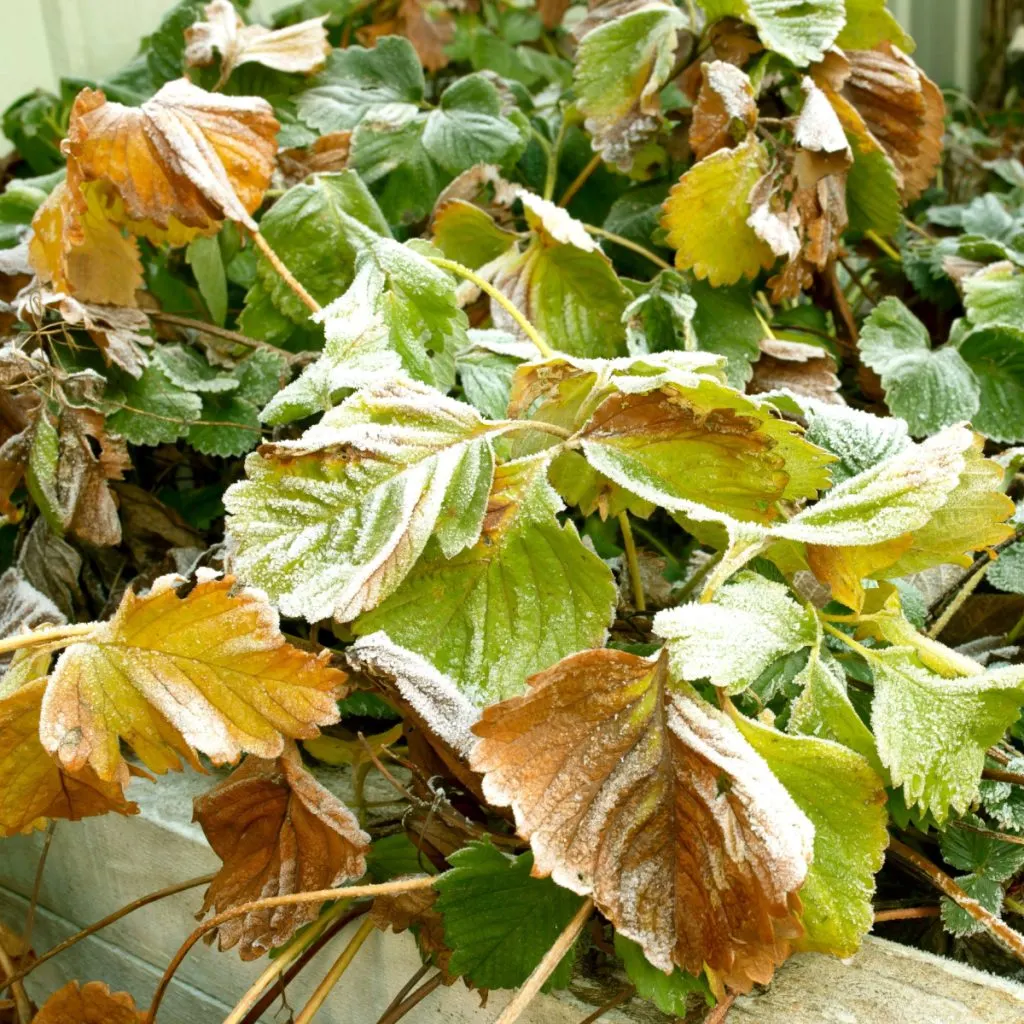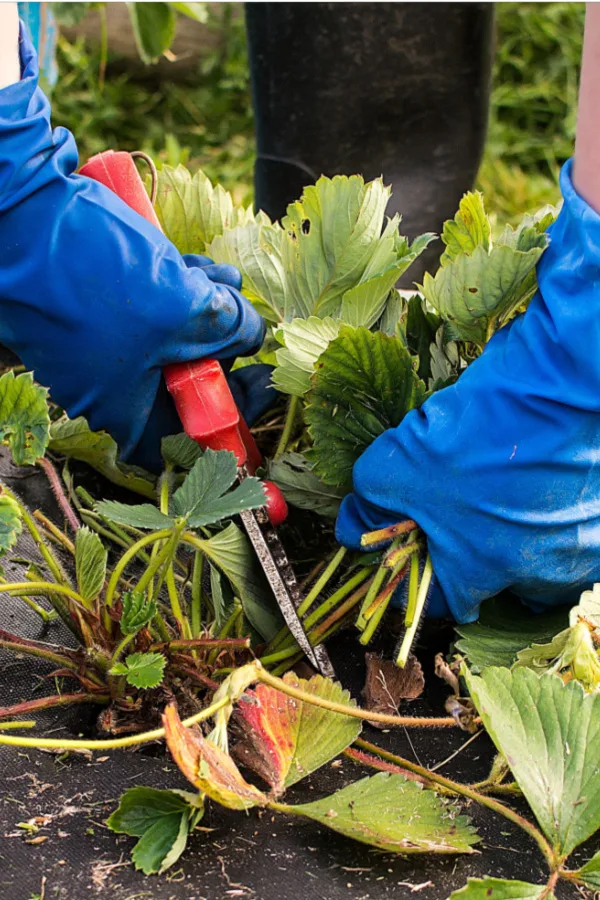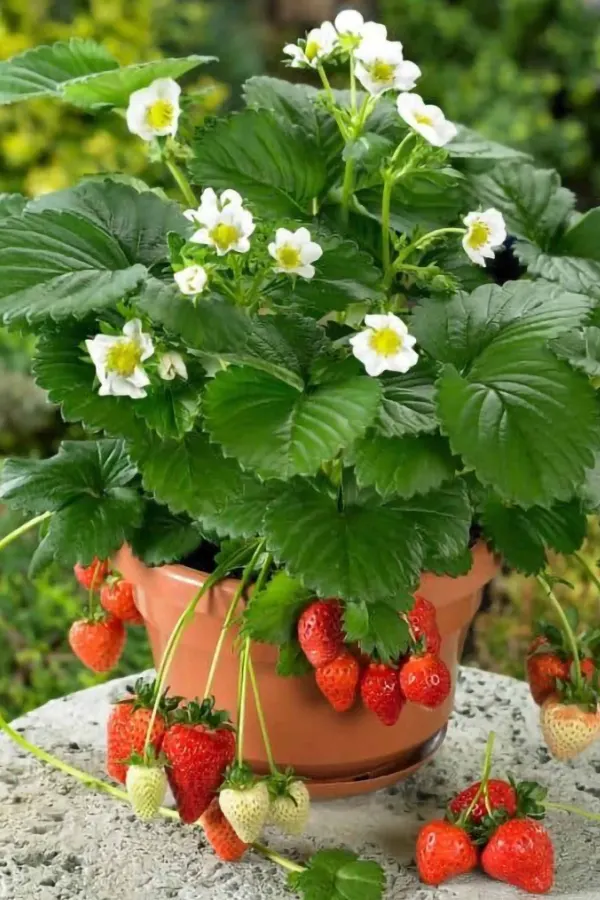No matter how you grow your strawberry plants, whether in the ground or in pots and containers, how you care for them in the fall before winter arrives can have a big impact on not just their survival – but also in how well they perform and produce next year.
Strawberries are one of the easiest perennials to grow. Once planted, they can produce a sizable harvest for years – all with minimal effort. But if there is one area where many gardeners struggle, it’s preparing them in the fall for the winter ahead.
Although strawberries are a hardy perennial in most climates, they do require a bit of assistance to survive what winter can throw at them. Especially if you happen to live in a climate where the temperatures can drop quite low. Unfortunately, without protection, strawberry plants can not only suffer big damage but in some cases, freeze completely out.

But, as you will see below, it’s also important in the fall to not give your strawberry plants too much care – especially when it comes to pruning. With all of that in mind – here is a look at how to get your strawberries more than ready for winter – and a big harvest next year!
What To Do With Strawberry Plants In The Fall – Before Winter Arrives!
Pruning
When it comes to strawberries, pruning does help to revitalize and re-energize plants. But one thing is for sure, it’s vital to never mow or prune back your strawberry plants in the fall. Especially June-bearing strawberry varieties.
Why is fall pruning bad for strawberry plants? For starters, next year’s fruit is already in process within the plants. Cutting them back at this point can eliminate most or nearly all of next year’s fruit. But even more, it leaves plants with little to no protection.
Unfortunately, in colder climates, cutting your plants back in late fall almost always will result in a total loss of your plants because they will freeze out. Even with a heavy protection of mulch.
Pruning should only be performed right after the last fruiting in the early summer. This gives the plants time to regrow before going into dormancy. This growth then helps to protect the plants throughout winter. See our article: What To Do With Strawberry Plants In The Summer

So what if you didn’t prune your plants in the summer? Your best course of action is to simply let them be and only mulch them. Then, next year, prune them back in early summer as soon as they finish fruiting. Now let’s cover how to protect your plants for winter – both for in ground plants, and strawberries growing in pots and containers.
How To Protect Strawberry Plants From Winter – What To Do With Strawberry Plants In The Fall
How you grow your strawberries plays a big role in how to protect them for winter. First and foremost, all strawberry plants need to be protected from the cold, no matter where they grow.
For plants that grow in a garden or raised bed setting, that means applying a heavy 4 to 6″ thick layer of mulch over plants in late fall. When it comes to mulch, the key is choosing a material that allows air to still get to the plants and roots below.
Mulching Options – What To Do With Strawberry Plants Before Winter
There are several options that work well for mulching strawberries. At the top of the list is straw. Straw provides good protection for the roots, but still allows plants to breathe and take in moisture over the winter.

Shredded leaves are another excellent choice. When using leaves, shredding is a much better option than whole leaves. Whole leaves can become soggy and thick, which will smother plants out. This is one time when oak leaves are an excellent choice as they provide a bit of acid to the soil as they break down, which is perfect for acid loving strawberry plants.
Pine needles are another mulching option (green needles are best for acidifying the soil) and also can give a little acid back to the plant. Be careful with adding too many as they can mat down much like whole leaves. The best option for pine needles is to mix them in with straw or shredded leaves.
So when is the best time to mulch your strawberries? Ideally, try to mulch in the fall once they have browned off and gone dormant for the season. Check near the crown of the plants, and if there is no new green foliage growing, they are ready for mulching.
Listen In To Our Podcast Below!

Potted Strawberry Plant Care Before Winter – What To Do With Strawberry Plants In The Fall
Potted strawberry plants are a bit more susceptible to the freezing temperatures of winter than those planted in the ground. Unless you live in an arid climate with warm winter temperatures, potted strawberries will need protection from freezing out.
But with that said, winter care is pretty simple and straightforward – that is – as long as you bring them in out of harm’s way!
An unheated garage, barn, or shed are all great options for giving potted strawberries protection. Bringing them out of the direct cold is a great start, but providing a little extra cover is a good idea. This can be done easily with a few different methods.
Placing pots inside of burlap sacks or wrapping them in burlap and filling with straw will usually do the trick. The burlap and straw provide protection, while still allowing the plants to breathe. Affiliate Product Link: All Natural Reusable Jute Burlap Sacks 24″ x 40″
Another option is to place pots in a 5 gallon bucket and surround it with straw or shredded leaves. If indoor space is limited, another great option is to bury the pots in the soil outside and cover with 6 inches of straw.

Be sure not to allow the soil in potted plants to completely dry out over winter. The plants still require moisture to survive, even in their dormant state. Check soil every week or so and water as needed. Once spring arrives, you can uncover and take back outdoors.
Here is to providing your strawberry plants with some great fall care, and preparing them for winter and for a great growing season next year!
This Is My Garden
Follow Our Facebook Page For Great Gardening Tips And Advice! This Is My Garden Facebook Page
This Is My Garden is a garden website created by gardeners, for gardeners. Jim and Mary Competti have been writing gardening, DIY and recipe articles and books and speaking for over 15 years from their 46 acre Ohio farm. They publish three articles every week, 52 weeks a year. Sign up today to follow via email, or follow along!
